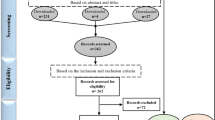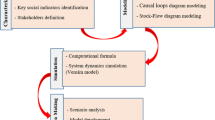Abstract
Water competition is a key issue in the study of the water-food-energy nexus (WFEN), which can affect water, food, and energy security and can generate notable challenges in water resource management. Since Bayesian network can express parameter uncertainty with a certain probability distribution while reflecting the dependencies of each variable, this study used a Bayesian network to model the WFEN in the Pearl River Region (PRR). The network structure can intuitively represent complex causal relationships, and the form of the probability distribution can effectively reflect the variable uncertainty. The responses of the Bayesian network model under different scenarios were used to analyse the major influencing factors, and water competition relationships in various sectors were explored. The results indicated that water competition between the different sectors was very complex and could dynamically change under the different scenarios. For example, an increase in hydropower and flow to sea could lead to a decrease in irrigation water, but an increase in irrigation water did not necessarily reduce hydropower and flow to sea. Water for hydropower generation and salt tide alleviation were obviously affected by the total offstream water use, but there existed no obvious water competition between these aspects in general. However, when offstream water use remained stable, a competitive relationship was observed between hydropower and flow to sea. Overall, the outcomes of this study could be of great significance to further analyse the WFEN in other regions.







Similar content being viewed by others
Data Availability
Evaporation data can be accessed at http://101.200.76.197/data/detail/dataCode/SURF_CLI_CHN_MUL_DAY_V3.0.html. Water Resources Bulletin data can be accessed at http://www.pearlwater.gov.cn/zwgkcs/lygb/szygb/andhttp://www.mwr.gov.cn/sj/#tjgb. Societal and economic data can be accessed at http://https--data--stats--gov--cn--e4192.proxy.www.stats.gov.cn/easyquery.htm?cn=C01. Salt tide data in the Water Resources Bulletin of Zhongshan can be accessed at http://water.zs.gov.cn/xxml/zwgk/szygb/index.html. The other data in this study were retrieved from published yearbooks, which are available by purchasing the yearbooks.
References
Aziz O, Hussain S, Rizwan M, Riaz M, Bashir S, Lin LR, Mehmood S, Imran M, Yaseen R, Lu GA (2018) Increasing water productivity, nitrogen economy, and grain yield of rice by water saving irrigation and fertilizer-N management. Environ Sci Pollut Res 25(17):16616–16619
Bonotto DM, Wijesiri B, Vergotti M, da Silveira EG, Goonetilleke A (2018) Assessing mercury pollution in Amazon River tributaries using a Bayesian Network approach. Ecotoxicol Environ Saf 166:354–358
Chai J, Shi HT, Lu QY, Hu Y (2020) Quantifying and predicting the Water-Energy-Food-Economy-Society-Environment Nexus based on Bayesian networks - A case study of China. J Clean Prod 256:120266
Chen WL, Zou HZ, Dong YJ (2014) Hydrodynamic of saltwater intrusion in the Modaomen waterway. Adv Water Sci 25(05):713–723 (In Chinese)
Deng ST, Chen T, Yang N, Qu L, Li MC, Chen D (2018) Spatial and temporal distribution of rainfall and drought characteristics across the Pearl River Basin. Sci Total Environ 619:28–41
D’Odorico P, Davis KF, Rosa L, Carr JA, Chiarelli D, Dell’Angelo J, Gephart J, MacDonald GK, Seekell DA, Suweis S, Rulli MC (2018) The Global Food-Energy-Water Nexus. Rev Geophys 56(3):456–531
El-Gafy I, Apul D (2021) Expanding the Dynamic Modeling of Water-Food-Energy Nexus to Include Environmental, Economic, and Social Aspects Based on Life Cycle Assessment Thinking. Water Resour Manage 35(13):4349–4362
FAO (Food and Agriculture Organization) (2014) Walking the Nexus Talk: Assessing the Water-Energy-Food Nexus in the Context of the Sustainable Energy for All Initiative. Rome, Food and Agriculture Organization of the United Nations
Farnaz NA, Song S, Qian CA (2017) Comparative analysis of discretization methods in Bayesian networks. Environ Model Softw 87:64–71
Govender IH, Sahlin U, O’Brien GC (2021) Bayesian Network Applications for Sustainable Holistic Water Resources Management: Modeling Opportunities for South Africa. Risk Analysis
Heckerman D, Gerger D, Chickering DM (1995) Learning Bayesian Networks: The Combination of Knowledge and Statistical Data. Mach Learn 20(3):197–243
Hoff H (2011) Understanding the Nexus. Background Paper for the Bonn 2011 Conference: The Water, Energy and Food Security Nexus. Stockholm Environment Institute, Stockholm
Legasa MN, Gutierrez JM (2020) Multisite Weather Generators Using Bayesian Networks: An Illustrative Case Study for Precipitation Occurrence. Water Resources Research, 56 (7), e2019WR026416
Li M, Fu Q, Singh VP, Ji Y, Liu D, Zhang CL, Li, & T.X (2019) An optimal modelling approach for managing agricultural water-energy-food nexus under uncertainty. Sci Total Environ 651:1416–1434
Liu XT, Huang XY (2000) A Brief Talk on the Countermeasures of Water Supply in Zhongshan City during Salt Tide Period. Proceedings of the 4th National Youth Academic Conference on Water Supply and Drainage, 107–112. [in Chinese]
Lu AQ, Peng J, Liang JX, Huang J(2011) Analysis on the Characteristics of Salt Tide Activity in the Estuary of Zhongshan City.Guangdong Water Resources and Hydropower, (S1),22–24. [in Chinese]
Marcot BG, Penmanb TD (2019) Advances in Bayesian network modelling: Integration of modelling technologies. Environ Model Softw 111:386–393
Molajou A, Pouladi P, Afshar A (2021) Incorporating Social System into Water-Food-Energy Nexus. Water Resour Manage 35:4561–4580
Neapolitan RE (1990) Probabilistic Reasoning in Expert Systems: Theory and Algorithms. John Wiley & Sons, New York. Currently out of print
Ouyang YR, Cai YP, Xie YL, Yue WC, Guo HJ (2021) Multi-scale simulation and dynamic coordination evaluation of water-energy-food and economy for the Pearl River Delta city cluster in China. Ecol Ind 130:108155
Pearl J (1988) Probabilistic Reasoning in Intelligent Systems: Networks of Plausible Inference. Morgan Kaufmann Publishers Inc., San Francisco
Pollino CA, Woodberry O, Nicholson A, Korb K, Hart BT (2007) Parameterisation and evaluation of a Bayesian network for use in an ecological risk assessment. Environ Model Softw 22:1140e1152
Porkka M, Guillaume JHA, Siebert S, Schaphoff S, Kummu M (2017) The use of food imports to overcome local limits to growth. Earths Future 5(4):393–407
Proctor K, Tabatabaie SMH, Murthy GS (2021) Gateway to the perspectives of the Food-Energy-Water nexus. Sci Total Environ 764:142852
Shi HY, Luo GP, Zheng HW, Chen CB, Bai J, Liu T, Ochege FU, De Maeyer P (2020) Coupling the water-energy-food-ecology nexus into a Bayesian network for water resources analysis and management in the Syr Darya River basin. J Hydrol 581:124387
Smajgl A, Ward J, Pluschke L (2016) The water-food-energy Nexus - Realising a new paradigm. J Hydrol 533:533–540
Tang K, Parsons DJ, Jude S (2019) Comparison of automatic and guided learning for Bayesian networks to analyse pipe failures in the water distribution system. Reliab Eng Syst Saf 186:24–36
UN (United Nations) (2015) Transforming our world: the 2030 Agenda for Sustainable Development. New York, United Nations
US NIC (United States National Intelligence Council) (2012) Global Trends 2030: Alternative Worlds. Washington DC, USA
Wang Y, Zhao Y, Wang YY, Ma XJ, Bo H, Luo J (2021) Supply-demand risk assessment and multi-scenario simulation of regional water-energy-food nexus: A case study of the Beijing-Tianjin-Hebei region. Resour Conserv Recycling 174:105799
Wu YP, Chen J (2013) Estimating irrigation water demand using an improved method and optimizing reservoir operation for water supply and hydropower generation: A case study of the Xinfengjiang reservoir in southern China. Agric Water Manage 116:110–121
Yan D, Yao MT, Ludwig F, Kabat P, Huang HQ, Hutjes RWA, Werners SE (2018) Exploring Future Water Shortage for Large River Basins under Different Water Allocation Strategies. Water Resour Manage 32(9):3071–3086
Zhang C, Chen XX, Li Y, Ding W, Fu GT (2018) Water-energy-food nexus: Concepts, questions and methodologies. J Hydrol 195:625–639
Zhang LW, Guo HP (2006) Introduction to Bayesian Networks. Beijing. The Science Press. (In Chinese)
Zhou XY, Zhang YQ, Sheng ZP, Manevski K, Andersen MN, Han SM, Li HL, Yang YH (2021) Did water-saving irrigation protect water resources over the past 40 years? A global analysis based on water accounting framework. Agric Water Manage 249:106793
Zou X, Yue WL(2017) A Bayesian Network Approach to Causation Analysis of Road Accidents Using Netica.Journal of Advanced Transportation,2525481
Funding
This study was supported by the National Natural Science Foundation of China (51909117), Natural Science Foundation of Shenzhen (JCYJ20210324105014039), Guangdong Provincial Key Laboratory of Soil and Groundwater Pollution Control, and State Environmental Protection Key Laboratory of Integrated Surface Water–Groundwater Pollution Control.
Author information
Authors and Affiliations
Contributions
Conceptualization: S. Liu and H. Shi; Methodology: Y. Shi, S. Liu, and H. Shi; Formal analysis: Y. Shi; Validation: Y. Shi; Supervision: H. Shi and S. Liu; Writing—original draft: Y. Shi; Writing—review and editing: H. Shi and S. Liu; Funding acquisition: H. Shi.
Corresponding author
Ethics declarations
Ethical approval
This paper does not contain any studies involving human participants or animals performed by any of the authors.
Consent to participate
Not applicable.
Consent to Publish
Not applicable.
Competing Interests
The authors declare that there are no conflicts of interest regarding the publication of this paper.
Additional information
Publisher’s Note
Springer Nature remains neutral with regard to jurisdictional claims in published maps and institutional affiliations.
Rights and permissions
About this article
Cite this article
Shi, Y., Liu, S. & Shi, H. Analysis of the Water-Food-Energy Nexus and Water Competition Based on a Bayesian Network. Water Resour Manage 36, 3349–3366 (2022). https://doi.org/10.1007/s11269-022-03205-1
Received:
Accepted:
Published:
Issue Date:
DOI: https://doi.org/10.1007/s11269-022-03205-1




